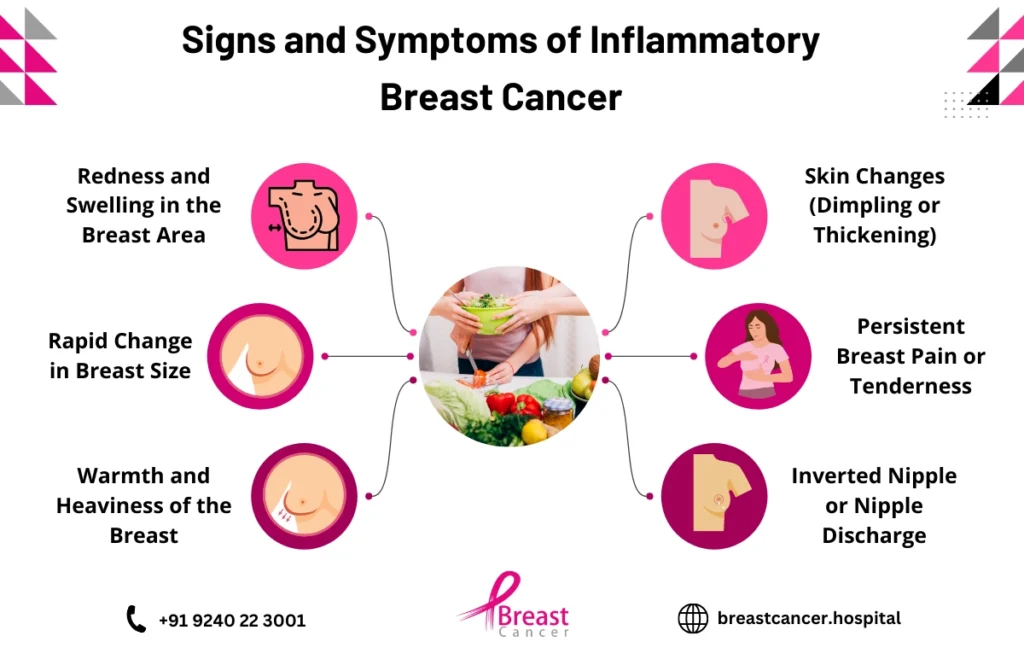Signs Inflammatory breast cancer is a critical topic, as this rare but aggressive form of breast cancer presents unique symptoms and requires prompt attention. Unlike other types of breast cancer, inflammatory breast cancer (IBC) often lacks a distinct lump and progresses rapidly, making it essential to recognize early signs. This blog will explore the symptoms, diagnosis, stages, and treatment options for inflammatory breast cancer to increase awareness and encourage timely action.

Signs Inflammatory Breast Cancer: Recognizing the Symptoms
Understanding Inflammatory Breast Cancer and Its Early Indicators
Signs Inflammatory breast cancer typically include redness, swelling, and warmth in the breast, often resembling an infection. IBC affects the lymphatic vessels in the breast skin, causing a blockage that leads to these visible symptoms. Because these symptoms can develop quickly, it is essential to seek medical attention if you notice any unusual changes in your breast’s appearance or feel.
Identifying these signs early on is crucial for effective inflammatory breast cancer diagnosis and treatment. This type of breast cancer is particularly aggressive, so being aware of even subtle changes can help in achieving a timely diagnosis.
Key Signs and Symptoms of Inflammatory Breast Cancer
1. Redness and Swelling in the Breast
One of the hallmark signs of inflammatory breast cancer is noticeable redness and swelling in the affected breast. This redness may appear patchy or cover a larger area, making the breast look as though it’s inflamed. This swelling is often accompanied by a sensation of warmth, which can easily be mistaken for an infection.
If you notice these symptoms, it’s important to consult a healthcare provider to rule out potential infections and consider the possibility of inflammatory breast cancer diagnosis. Unlike common breast infections, the redness and swelling in IBC do not typically respond to antibiotics, which is why professional assessment is crucial.
2. Dimpling or Pitting of the Skin
Inflammatory breast cancer can cause the skin over the breast to take on an orange-peel texture, known as peau d’orange. This symptom occurs due to blocked lymph vessels that cause the skin to pit or dimple. This unique texture change is an important sign to look out for, especially if it appears suddenly and without explanation.
Dimpling can occur along with other symptoms or as an early sign, making it a vital aspect of inflammatory breast cancer diagnosis. Any skin changes, especially if persistent, should prompt an immediate visit to a healthcare provider to discuss possible causes and conduct necessary tests.
3. Breast Pain and Tenderness
Breast pain and tenderness are also common signs of inflammatory breast cancer. Unlike typical breast pain associated with menstrual cycles, the pain in IBC can be persistent and concentrated in one area. This discomfort may accompany other symptoms, such as swelling and redness, creating a feeling of heaviness in the breast.
The combination of these symptoms warrants an immediate check-up, as inflammatory breast cancer is known for progressing rapidly. Seeking early diagnosis can help determine if the pain is related to IBC or another underlying condition, helping to catch potential issues at a manageable stage.
4. Rapid Increase in Breast Size
A sudden and noticeable increase in breast size without an obvious cause is another symptom of inflammatory breast cancer. As IBC progresses, the swelling in the breast tissue can cause one breast to appear significantly larger than the other. This rapid growth is a warning sign that should not be ignored, as it may indicate an underlying blockage in the lymphatic system.
Early recognition of these signs inflammatory breast cancer can facilitate timely inflammatory breast cancer diagnosis and subsequent treatment planning. Consulting a healthcare professional when changes like these occur can be a key step in addressing symptoms effectively.
Inflammatory Breast Cancer Diagnosis, Stages, and Treatment Options
Inflammatory Breast Cancer Diagnosis
An accurate inflammatory breast cancer diagnosis is critical for determining the most effective treatment approach. Diagnosis typically involves a physical exam, imaging tests such as a mammogram or ultrasound, and a biopsy to confirm the presence of cancer cells. MRI scans may also be used to detect the extent of the spread, helping to understand how the cancer is affecting surrounding tissues.
Since IBC often progresses quickly, healthcare providers may recommend immediate diagnostic tests if symptoms align with signs of inflammatory breast cancer. Prompt diagnosis allows for faster treatment initiation, which is essential for improving patient outcomes with this aggressive cancer.
Inflammatory Breast Cancer Stages
Inflammatory breast cancer stages are usually determined by how far the cancer has spread within and beyond the breast. IBC is often diagnosed at Stage III or IV due to its rapid progression, meaning it has typically affected nearby lymph nodes or distant organs. Stage III indicates localized spread, while Stage IV signifies metastasis to distant areas of the body.
Understanding these stages is important as they influence the inflammatory breast cancer treatment approach. For example, Stage III cases may respond well to localized treatments, while Stage IV cases require systemic therapies to address cancer cells throughout the body.
Inflammatory Breast Cancer Treatment Options
Inflammatory breast cancer treatment generally involves a combination of chemotherapy, surgery, and radiation therapy. Chemotherapy is often the first line of treatment to shrink the tumor, followed by surgery to remove any remaining cancerous tissue. Radiation therapy helps target residual cells and minimize recurrence risks.
In some cases, targeted therapies and hormone treatments may be used, depending on the cancer’s hormone receptor status. Since IBC is aggressive, the treatment plan often includes multiple therapies to ensure all areas affected by the cancer are addressed, increasing the chances of a successful outcome.
What Complications Are Associated with Inflammatory Breast Cancer?
Inflammatory breast cancer is known for its aggressive nature and rapid progression. Without early detection and treatment, it can lead to serious complications, including:
- Metastasis: One of the most severe complications is the spread of cancer to other parts of the body, such as the lungs, liver, or bones. Signs Inflammatory breast cancer often metastasizes early.
- Lymph node involvement: Since IBC affects the lymphatic system, it can cause swelling and blockage of lymph nodes, leading to further complications.
- Skin ulcers and infections: As the cancer spreads, the skin on the breast may break down, leading to painful ulcers and possible infections.
- Decreased quality of life: Due to the rapid onset of symptoms and aggressive nature of the disease, patients often experience emotional and physical distress.
- Recurrence: Even after initial treatment, inflammatory breast cancer has a higher likelihood of recurring compared to other types of breast cancer.
Can Inflammatory Breast Cancer (IBC) Be Prevented?
Unfortunately, inflammatory breast cancer cannot be fully prevented, but there are steps you can take to reduce your risk. While the causes of IBC are not entirely understood, there are factors that may influence its development:
- Genetics and family history: Women with a family history of breast cancer may be at a higher risk, though IBC is more likely to occur sporadically.
- Hormonal factors: High levels of estrogen and progesterone may influence breast cancer development. Hormone replacement therapy (HRT) can increase the risk of breast cancer in general, but there’s no specific data on IBC.
- Obesity: Being overweight or obese can increase the risk of various types of breast cancer, including IBC.
- Age: IBC can affect women of any age but is more common in those under 50.
While inflammatory breast cancer diagnosis can’t be predicted, maintaining a healthy lifestyle, getting regular screenings, and discussing your risk factors with a healthcare provider can aid in early detection, which significantly improves outcomes.
Survival for Inflammatory Breast Cancer
Survival rates for Signs inflammatory breast cancer are generally lower than for other types of breast cancer due to its aggressive nature. However, with early detection and modern treatment approaches, survival rates have improved over the years.
- 5-year survival rate: The overall 5-year survival rate for IBC is approximately 40-50%, but this can vary based on the stage at diagnosis, treatment received, and individual health factors.
- Stage 1: Higher chances of survival, with treatments often curbing further spread.
- Stage 4: Survival rates are lower, but advancements in chemotherapy and targeted therapies offer hope for managing the disease.
As research continues and treatment options improve, more individuals diagnosed with Signs inflammatory breast cancer are surviving longer and living better-quality lives.
Conclusion
Recognizing the signs inflammatory breast cancer is essential for early intervention and effective treatment. By being aware of symptoms like redness, swelling, pain, and skin changes, individuals can seek medical attention early and improve their chances of successful management. Timely inflammatory breast cancer diagnosis and understanding inflammatory breast cancer stages and treatment options can significantly impact outcomes.
Taking action by consulting a healthcare provider if you notice any unusual changes can make a difference in managing inflammatory breast cancer. Proactive health care, awareness of symptoms, and understanding treatment possibilities empower individuals to navigate this challenging diagnosis with hope and resilience.




